The Woolworths Museum
Picot Mix Special Feature
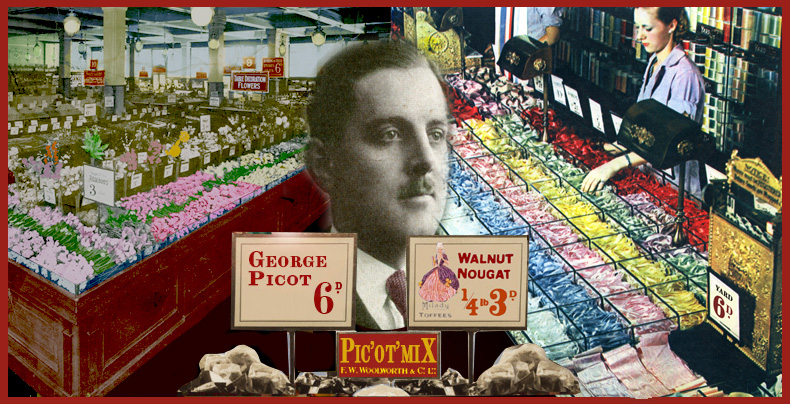
 George Fauvel Picot
George Fauvel Picot
A self-effacing Great War hero who recovered from a severe injury
to become a successful, authoritative leader of a flagship London store,
but seemed equally fulfilled working diligently behind the scenes
George Fauvel Picot was born in St. Helier, Jersey, Channel Islands in 1897, the fourth of five sons of Matthew J.F. and Elizabeth Picot. He also had a sister who was his senior by three years. At the turn of the twentieth century the Picots moved to the Mainland, setting up home in Tunbridge Wells, Kent. George's older brother Frank joined the British Army, enlisting in 1910 and soon rising to become a Sergeant in the Royal Artillery Ordnance Corps, based at Woolwich Arsenal. When War was declared in 1914 George decided to follow his brother's example, volunteering for the Royal Welsh Fusileers and rising to the rank of Corporal. He survived four years of trench warfare, earning a reputation for bravery and courage under fire, before suffering a severe minefield injury as the long conflict drew to a close. He was discharged for rehabilitation at the 2nd Durham VA Hospital in South Shields. He would have to learn to walk again and overcome the trauma of his injuries.
Initially progress was slow until his Doctors summoned brother Frank. The siblings explored the problem together and came up with a solution. At just twenty-six years of age George had seen more death, destruction and horrific injuries than most people do in a lifetime. This had left him with terrible survivor's guilt, and a sense that there was little to look forward to, or worth recovering for. Frank explained the role that Woolworth's had played in his transition from being discharged from the Army and carving a niche for himself in Civvy Street. He had found the work interesting and challenging, the rewards generous and virtually unlimited possibilities for advancement for those with the skills and dedication to give it a go. Frank could easily set up an interview with the MD once George was back on his feet again. The two shook hands on it and before long George was on the mend.
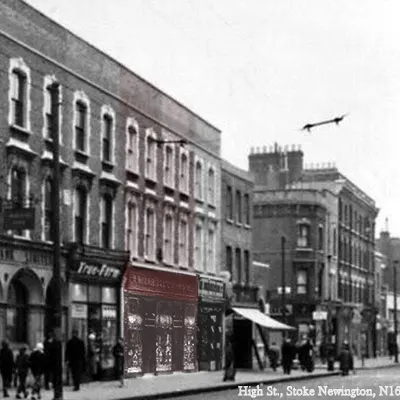 The American supremo of the High Street chain, Fred Moore Woolworth, favoured veterans, and had struck up a friendship with Frank, guiding his career from above. He was happy to make time for a younger Picot, liked George, and hired him as a Learner (Management Trainee) in February 1920. After two years learning the ropes from the ground-up, including a spell setting up South Shields for his brother, George was given a store in the North London suburb of Stoke Newington.
The American supremo of the High Street chain, Fred Moore Woolworth, favoured veterans, and had struck up a friendship with Frank, guiding his career from above. He was happy to make time for a younger Picot, liked George, and hired him as a Learner (Management Trainee) in February 1920. After two years learning the ropes from the ground-up, including a spell setting up South Shields for his brother, George was given a store in the North London suburb of Stoke Newington.
The outlet had been one of a number adapted from existing shop units during the early months of the First World War. As battle raged in France, the Government had redirected some of the fixture suppliers onto war work, leading to shortages and forcing some compromises. For example a signwriter repainted and re-lettered the existing fascia, and a carpenter adapted some of the previous tenant's counters, rather than buying new. Despite this, the new branch had opened to great acclaim.
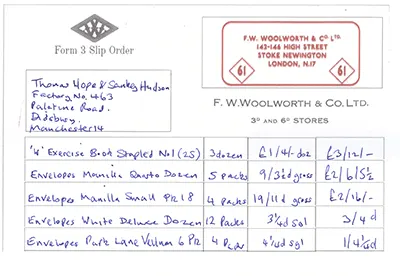 George's main tasks were to get the shopfittings up to specification and to sharpen the processes governing product promotion and routine weekly stock counting and ordering. The goal was to improve availability to customers and reduce the capital tied up in excess inventory of the slower sellers.
George's main tasks were to get the shopfittings up to specification and to sharpen the processes governing product promotion and routine weekly stock counting and ordering. The goal was to improve availability to customers and reduce the capital tied up in excess inventory of the slower sellers.
Over a three month period he systematically worked through his range of four thousand items, calculating accurate stock commitments based on historic demand, and implemented a calendar that would ensure that he personally validated every line-item stock count at least once a quarter. He also commited to check and countersign every Form 3 order raised by his store.
In parallel he tracked down the suppliers of the Company's standard store front fascia kits and the factory that mass-produced its mahogany wall and floor-standing island counters and obtained a price list. He raised a business case to persuade the Real Estate Department at District Office to capitalize two islands and a short small store fascia as 'essential shopfittings', spreading the cost across 120 monthly repayments in the store's profit and loss account, before placing the order. After a four-week lead-time, the installation took two days, with the fascia installed during daylight hours with one gondola installed the night before, and the other the night after.
Sales and profits began to rise rapidly, winning nods of approval at District Office His diligent work on the stock commitments and his prudence over the recharge costs for the fixtures, showed that he had understood his training and demonstrated the dedication and financial acumen required to take the helm of a much large larger store just twenty-one months after first being appointed as a Store Manager.
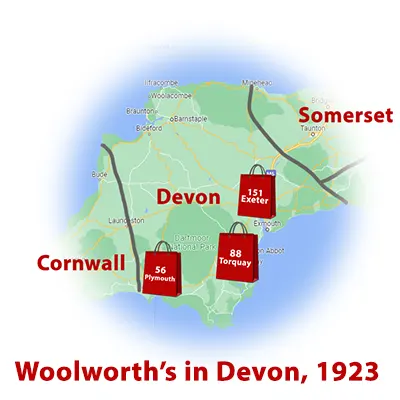 As life returned to normal after the Armistice, Woolworth was able to revive its expansion plans, continuing the steady march to open outlets in every county across the British Isles. George was invited to lead the charge West, taking responsibility for planning and managing the opening in Exeter, the county town of Devon. It would be the county's third store, complementing Plymouth (No. 56, opened 2/10/1915) and Torquay (No. 88, opened 7/02/1920).
As life returned to normal after the Armistice, Woolworth was able to revive its expansion plans, continuing the steady march to open outlets in every county across the British Isles. George was invited to lead the charge West, taking responsibility for planning and managing the opening in Exeter, the county town of Devon. It would be the county's third store, complementing Plymouth (No. 56, opened 2/10/1915) and Torquay (No. 88, opened 7/02/1920).
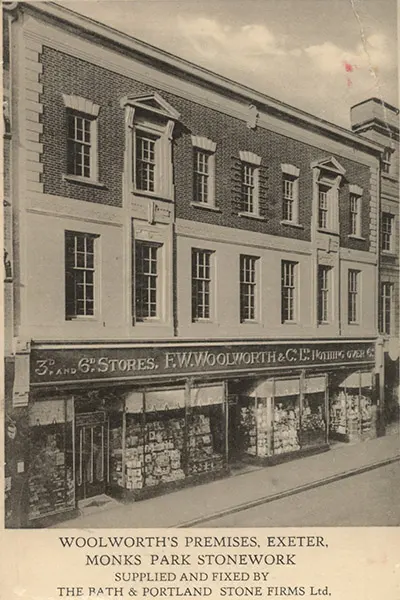
Brother Frank was invited as a special guest at Exeter's preview day on Friday November 30, 1923 and the grand opening the following morning. He admired the regimented displays of staple lines around the store, and the unusually high levels of availability that his brother had achieved - clearly a chip off the old block - but was positively taken aback by the elegant displays of toys, accessories and Christmas Decorations. Clearly George had a creative side and had allowed those softer skills to shine through his traditionally rather reserved persona. He had made several oversized wrapped parcels which were dangling in mid air above the aisles, giving the store a magical Aladdin's cave look, which would be very good for sales.
After a busy day in-store, Frank and his wife Lucy took George and his fiancée Cicely Hooper out for dinner at a smart City-centre restaurant to celebrate a very successful opening. The brothers toasted their Founding MD Fred Moore Woolworth, who had been cruelly felled by a second huge stroke on 27 January 1923.
Fred had proved a true friend, giving them many reasons to be grateful. In showing faith in the two military men, both of whom had been forced out of the Army by injuries sustained in uniform and retraining them for commercial careers, he had helped each to find a new purpose that was both fulfilling and lucrative, and would provide a good living for years to come. The brothers had supported each other through difficult times, strengthening the bond between them.
George and Cicely tied the knot in June 1924 at a simple ceremony near Frank's home in Croydon, and spent their first four years together in the St Leonard's District, which was about twenty minutes' brisk walk from the Exeter store. George built a happy, friendly and efficient team who could run his store like clockwork, freeing him to play a larger role in the City's commercial life. The couple raised money for charity, laid on meals for the homeless and Christmas gifts for orphans and hospital-bound children. Despite increasingly stretching targets, George was able to exceed the level of sales and profit for a full bonus each year, and squirreled the money away to buy a dream home. After four idyllic years in Exeter, Picot was invited to take the helm of a premier London store at the heart of the City's financial district in High Holborn, which was one of the chain's key flagships.
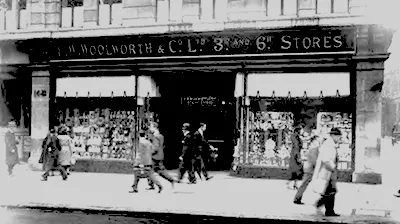 Store 173 was one of Woolworth's most iconic shops, situated at the heart of High Holborn, facing the City of London's famous old houses, which had been a popular tourist destination for many years. The branch had opened in 1924 and had proved a surprise hit, selling both practical products used for maintaining and cleaning the many offices and shops in the District, and everyday essentials, needs and treats to the many thousands of commuters who travelled into the area each weekday, or spent their lunch hours out shopping.
Store 173 was one of Woolworth's most iconic shops, situated at the heart of High Holborn, facing the City of London's famous old houses, which had been a popular tourist destination for many years. The branch had opened in 1924 and had proved a surprise hit, selling both practical products used for maintaining and cleaning the many offices and shops in the District, and everyday essentials, needs and treats to the many thousands of commuters who travelled into the area each weekday, or spent their lunch hours out shopping.
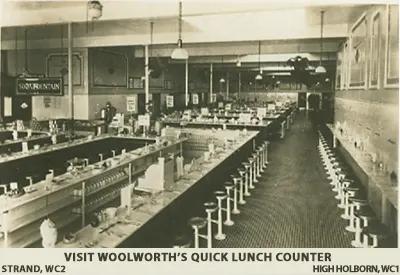
Its quick service lunch counter was a particular favourite with the clerk typists, telephonists and telegraphists of the financial district, serving nutritious and appetising lunches for as little as sixpence quickly and without a fuss. Trading had much steeper peaks and troughs than in a typical store, making the Store Manager's role particularly challenging. George would need to ensure that tip-top quick service was given during the peaks without paying staff to stand idle during the troughs, and plan the store's workload to ensure that gaps on the counters were filled during the quieter times, releasing staff for service if a queue formed.
George found High Holborn physically demanding. The combination of having to stand on a suburban train into town and again on the Tube, and the need to direct service from a standing position on the salesfloor meant he spent much more time on his feet, aggravating worn joints in his knees and ankles and causing the remaining shrapnel buried deep in his bones to move, leaving him in pain and irritable. The happy, laid-back Exeter Manager gradually morphed into an angry, snappy manager who barked at his staff and could be impatient with customers. Soon the Superintendent had noticed and his observations had filtered back to William Stephenson, who had succeeded Fred Woolworth as MD. In ordinary times the supremo would have worked around the problem given Picot's war hero credentials, but plans to take the British Woolworth's public, listing its shares in London, would put High Holborn in the spotlight. Standing just three quarters of a mile from the Stock Exchange in Paternoster Square, inevitably Store 173 would draw lots of broker attention in the run-up to the initial public offering. The ideal High Holborn Manager would be capable of charming the birds from the trees, not biting their heads off! So Stephenson would need to ease this Manager gently out of the way, using all the tact and discretion he could muster.
George conducted his annual inventory in the run up to the new decade between Christmas 1929 and the New Year, and was pleased with the result. Sales and profit were both ahead of target and shrinkage appeared well under control. When he submitted the Inventory Book to District Office he doubted he would hear any more about it, give or take receiving a healthy bonus computed on the store's contribution to the coffers. He was surprised to receive a summons to meet with Frank Sprague, the American Manager of the Woolworth's Metropolitan District of stores across London and the South East.
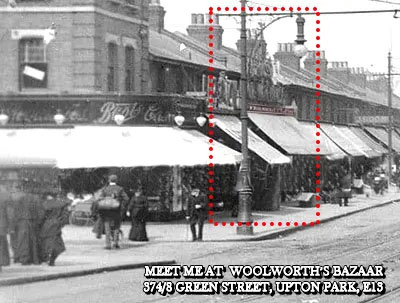 At the session Sprague outlined Stephenson's concerns about George's declining health and increasingly fiery temperament, and his proposed solution. The boss proposed a no fault move to Upton Park in East London, without any reduction in salary or bonus. The store was quieter, with a turnover of £40k per annum compared with £60k at Holborn, but had a much lower rent meaning that it generated more profit for each pound taken through the till. More importantly it would be much less stressful to manage, which could largely be done from a seated position. A proud man, George was very disappointed but felt obliged to put on a brave face, accept the offer and ask his DM to pass on his sincere thanks to the MD for being so kind and generous in easing his suffering.
At the session Sprague outlined Stephenson's concerns about George's declining health and increasingly fiery temperament, and his proposed solution. The boss proposed a no fault move to Upton Park in East London, without any reduction in salary or bonus. The store was quieter, with a turnover of £40k per annum compared with £60k at Holborn, but had a much lower rent meaning that it generated more profit for each pound taken through the till. More importantly it would be much less stressful to manage, which could largely be done from a seated position. A proud man, George was very disappointed but felt obliged to put on a brave face, accept the offer and ask his DM to pass on his sincere thanks to the MD for being so kind and generous in easing his suffering.
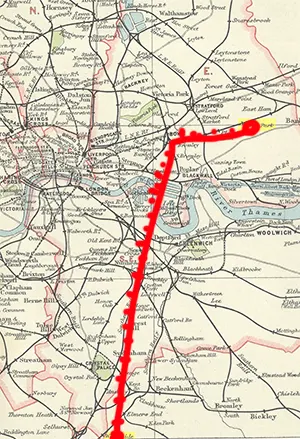
The MD's generosity went only just so far. While had had found a store which could sustain Picot's remuneration and would benefit from his skills, whether standing or seated, the commute would be even more difficult. George and Cicely's dream home was on the outskirts of Croydon at the southern tip of London. The couple had taken in his sister Mary, a local schoolteacher, and father Matthew, who she nursed in old age.
The Upton Park store lay right across London at the outer extent of the docks, far east of Tower Bridge. It could be reached by car via a slow stop-start drive along the South Circular Road to Greenwich, then through the Blackwall Tunnel to Essex and along the North Circular towards Ilford turning into Upton Park at the penultimate exit. By public transport George would have to take a suburban train to Victoria before transferring to the Underground to rattle eighteen stops along beside the Thames to Upton Park on the District Line. Door-to-door could take up to ninety minutes by either route, quite an endurance test with shrapnel wounds and aching joints. George persevered for thirty months. He became a popular and inspirational manager, achieving a much higher standard than the store had seen before. But when Frank proposed the more radical option, George didn't hesitate, embracing it with enthusiasm. He resolved to take control of his own destiny.
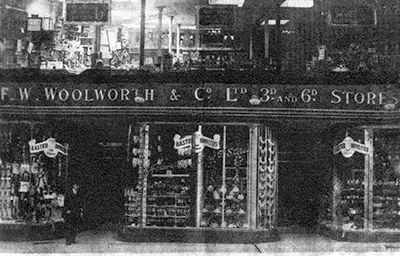 After his move to Brixton in January 1932, Frank began to spend one to two days a week at District Office in Oxford Street and HQ at New Bond Street House round the corner, meeting with the Merchandise Men, Buyers and Store Planners. During idle chit-chat he heard of an interesting new role at the Edgware Road store which he thought might appeal to George. It would involve stepping away from the standard Woolworth's hierarchy and trying something new and off the beaten track. It appeared to have the potential to provide a good income without much of the stress of Store Management.
After his move to Brixton in January 1932, Frank began to spend one to two days a week at District Office in Oxford Street and HQ at New Bond Street House round the corner, meeting with the Merchandise Men, Buyers and Store Planners. During idle chit-chat he heard of an interesting new role at the Edgware Road store which he thought might appeal to George. It would involve stepping away from the standard Woolworth's hierarchy and trying something new and off the beaten track. It appeared to have the potential to provide a good income without much of the stress of Store Management.
For several years senior executives had infuriated the Managers of the Edgware Road flagship store with their demands for stock, fixtures and assistance as they prepared photographs and display layout plans in rooms that had been allocated to them on the first floor of the store. The hierarchical firm's top brass expected Store Managers to wait on them hand and foot, making their needs a top priority even though they had little to do with running the store.
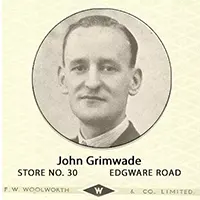 John Grimwade, the Store Manager could see how the photos and layout plans benefitted the Company, using them regularly to lay out his own displays, and was happy to support the production process, but felt it would be more productive to delegate most of the day-to-day activity to someone who would become an expert over time. So he took the initiative with a radical solution. He would hire a career Associate General Manager and finance a reasonably generous fixed salary akin to the Manager of medium-sized store in inner London. There would be no bonus, but a guaranteed regular income. The job would report jointly to the Store Manager - perhaps also deputising for him in-store from time to time - and the EO Rep for the Metropolitan District, who acted as the bridge between the stores, and the District and Executive Offices.
John Grimwade, the Store Manager could see how the photos and layout plans benefitted the Company, using them regularly to lay out his own displays, and was happy to support the production process, but felt it would be more productive to delegate most of the day-to-day activity to someone who would become an expert over time. So he took the initiative with a radical solution. He would hire a career Associate General Manager and finance a reasonably generous fixed salary akin to the Manager of medium-sized store in inner London. There would be no bonus, but a guaranteed regular income. The job would report jointly to the Store Manager - perhaps also deputising for him in-store from time to time - and the EO Rep for the Metropolitan District, who acted as the bridge between the stores, and the District and Executive Offices.
The AGM would act as Mr Fix It, facilitating each task, negotiating for store labour when it was required for cleaning, setting up or taking down displays, arranging for photographs to be taken, duplicated and distributed, and for any items not available locally to be sourced on loan from neighbouring branches or the reserves of the nearby Co-operative Warehouse at St Pancras. This would free Grimwade to manage the service of the busy store, and would improve the service to the Executives, providing an expert with many years of store management experience, who could both assist and advise. All were agreed that this would be a win-win and Frank's initial soundings with the team showed that George sounded ideal for the role.
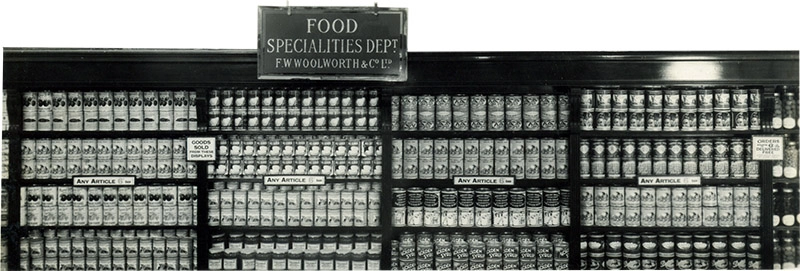
When Frank rather tentatively brooched the subject he was surprised at how quickly his brother saw the merits of the idea. The Edgware Road store would be much easier to reach, standing under two miles from London Victoria station. George had always loved display and the creative side of the job, and the job could be paced to allow him to sit down for a few moments when he needed a rest, while still moving around enough to keep himself mobile. He had no concerns at the idea of resigning his role as a Store Manager and sacrificing his position in the hierarchy, not least because he always had a full invalidity pension to fall back on. He also liked the idea of no longer having to worry about shrinkage and a hundred and one other daily minutiae of Store Management. He leapt at the chance, made a go of it, and became an indispensible part of those display teams for the rest of the decade. It was only the demands of the Home Front during World War II that saw him pressed back into Service as a Store Manager from 1940 to 1946.
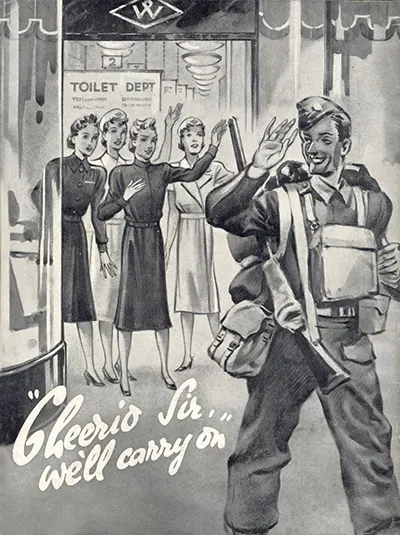
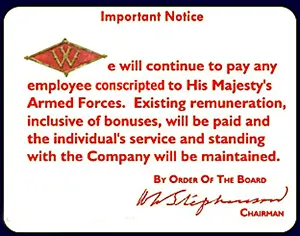 Soon after war was declared in August 1939 Managers started to vanish from the stores. Some headed off in uniform, others were hand-picked for special duties by the Woolworth Chairman. He had agreed to boost Spitfire production for the Air Ministry, and chose two dozen of the brightest and best to help him.
Soon after war was declared in August 1939 Managers started to vanish from the stores. Some headed off in uniform, others were hand-picked for special duties by the Woolworth Chairman. He had agreed to boost Spitfire production for the Air Ministry, and chose two dozen of the brightest and best to help him.
A carefully crafted policy discouraged volunteering to slow the flow, but by Spring 1940 a trickle had become a torrent and the Company was running out of Managers. District Managers were asked to trawl their records and identify qualified store managers who had retired or opted to move to other roles, and persuade them to do their duty on the Home Front and return to public service. In parallel Superintendents were asked to consider all of their Floor Walkers, Supervisors and Office Managers, identifying those with the strength of personality and intellect to step up as temporary managers.
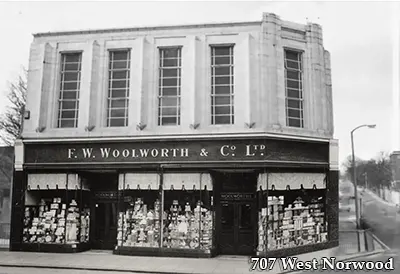 Eight years after stepping down from the helm of Upton Park, George found himself called upon to serve again. The Company's offer was carefully considered, inviting him to take the helm at the medium-sized suburban store in West Norwood, about four miles north of his home in Croydon, which would be a convenient fifteen minute commute on the No. 68 bus or No. 2 Tram, which stopped right outside. He was asked to provide temporary cover for a conscripted manager, and offered a commission rate of over ten percent, which at a time of rapidly rising prices and surprising sales success for the Company would guarantee a very strong income. His task would be to steady the ship, keeping the staff happy and motivated despite regular day and night-time visits by the Luftwaffe targeting Croydon's heavy industry.
Eight years after stepping down from the helm of Upton Park, George found himself called upon to serve again. The Company's offer was carefully considered, inviting him to take the helm at the medium-sized suburban store in West Norwood, about four miles north of his home in Croydon, which would be a convenient fifteen minute commute on the No. 68 bus or No. 2 Tram, which stopped right outside. He was asked to provide temporary cover for a conscripted manager, and offered a commission rate of over ten percent, which at a time of rapidly rising prices and surprising sales success for the Company would guarantee a very strong income. His task would be to steady the ship, keeping the staff happy and motivated despite regular day and night-time visits by the Luftwaffe targeting Croydon's heavy industry.
Over his two years at West Norwood there were major changes to the range, displays and pricing. As factories switched to war production and reserves of imported items ran out, there were fewer ornaments, decorative items, toys and playthings, but after the sixpenny maximum limit was relaxed there was a new selection of fashions, along with many items to support the national make do and mend and dig for victory campaigns. The food range was also quadrupled in size, as the Company worked with the Ministry of Food's experimental kitchens, marketing the most promising new foodstuffs to come out of a drive new sources of nutrition that could help Britain to make up for the shortfall in imported food. The largest features were of 'Canned Snook' a very salty and chewy fish that was a distant relative of both tuna and mackerel, and powdered soups that could be reconsistituted with boiling water. Cup-a-soups have remained popular ever since, while, despite free recipes and heavy marketing, most of the snook only finally cleared once in had been relabelled as cat food after the War!
George set about training the Office Manager and Floor Walker to deputise for him, with the three taking it in turns to sleep in the store overnight as firewatchers, with stirrup pumps at the ready by their side to extinguish any incendiary bombs that hit the store or any burning embers from neighbouring properties.
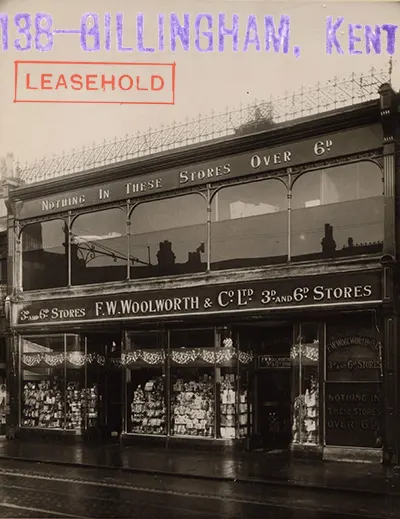 George was settled at West Norwood, producing good results while also protecting his health. It seemed he would serve the war out there.
George was settled at West Norwood, producing good results while also protecting his health. It seemed he would serve the war out there.
But Executives felt that he had more to give, and went to lengths to persuade him to accept a more stretching Store Management role. Trade at the store on the River Medway at Gillingham (No. 138) had rocketed during World War II, as the population was boosted by extra recruits conscripted to bolster the Royal Naval Dockyard that stretched along the shore to Chatham. Local factories and service industries were also expanded to meet the demands of the war effort. Woolworth considered the store particularly vulnerable to attack because of its strategic importance, and when it received news that the Store Manager would shortly be conscripted for War Service it felt he should be replaced by a high calibre, experienced Store Manager rather than a member of its staff stepping up into the job.
Recognising George's disability, before making the offer it had made tentative arrangements for petrol ration coupons to be issued to allow him to make the daily journey 35 mile trip down the A232/A2 from Croydon by car, parking securely in the yard behind the store.
It seems that George considered the approach to be a compliment, and saw it as his duty to accept the role, particularly given the importance of Dockyard to the nation's war effort. Ironically Company records show his acceptance of the new job on exactly the same day as his older brother Frank was officially transferred from the role of Manager at Store 74 Ealing onto Company Sick Leave. Frank and Lucy had told the family that they hoped this was a temporary move and that he would soon be on the mend, keeping the severity of his illness to themselves.
George remained at the helm in Gillingham until Spring 1946 when the Store Manager was finally demobilized. He chose to exercise his legal right to return to the role he held before being conscripted. By all accounts Picot had been a competent Manager who commanded respect in-store, even though after his brother's death he seemed reserved and distant. He chose to leave the Company rather than take the offer of promotion to manage another Store, or the chance to return to the Edgware Road flagship store as AGM and head of an enlarged and enhanced display team. He had served Woolworth's for more than twenty-five years, and like other members of the family had seen it at both its best and worst. The Woolworths Museum is proud to celebrate his distinguished and loyal service to the business as one of its finest sons.
Shortcuts to the other pages in the Picot Mix Special Feature
The current page is highlighted and emboldened